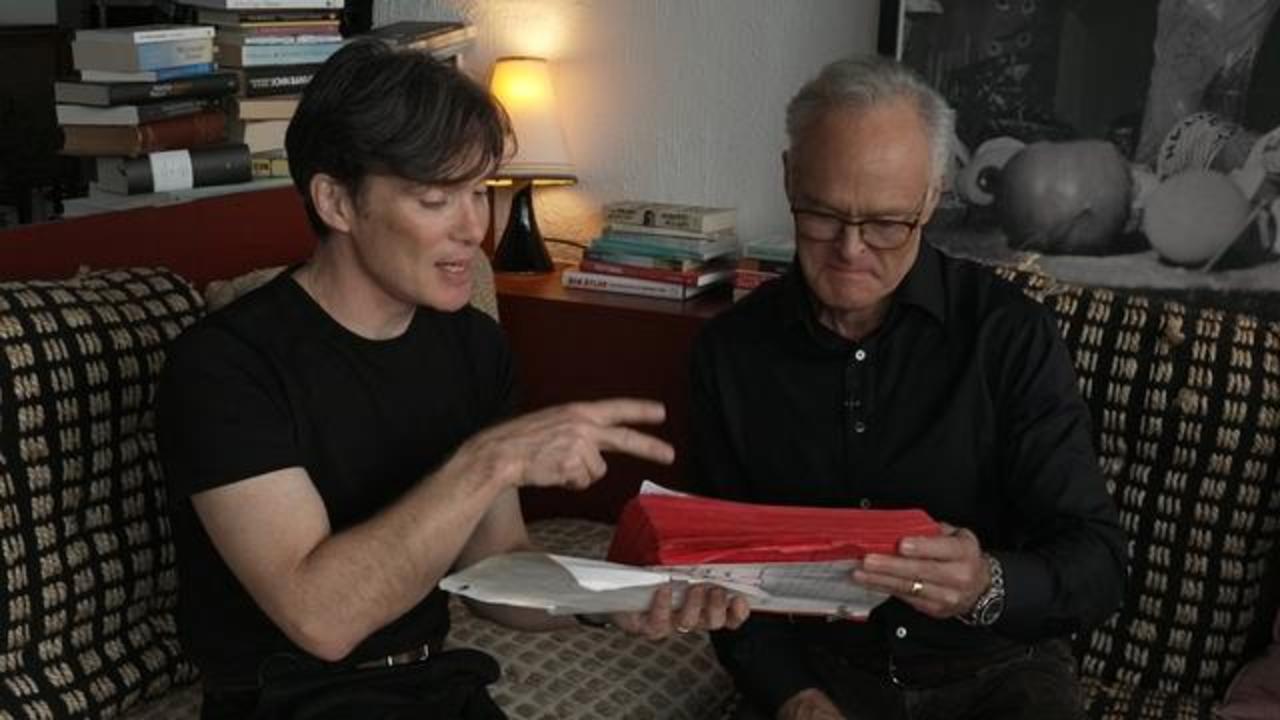by David Huston
Swiss surrealist H.R. Giger lounges on a brocade sofa in a suite at the Chateau Marmont—Los Angeles’ most gothic old hotel. He’s dressed casually, comfortably—but all in black. The 20th Century-Fox blockbuster Alien opened the night before, and the reviews were good. Lines are already wrapping around theater blocks.
“I’m very glad,” Giger says with a pleasant smile. “I wouldn’t like to spend a year and a half of my life on something that did not amount to anything.”
The monsters in Alien were designed and realized by Giger. The derelict extraterrestrial ship and its decayed occupant are of his invention too, as are the planetary landscapes.
Giger’s involvement in the film was assured when its director, Ridley Scott, arrived for his first meeting at Fox and was shown a new art book called The Necronomicon. “I took one look at it,” says Scott, “and I’ve never been so sure of anything in my life. ” He flew to Zurich to secure the talents of its artist, H.R. Giger. (See the Ridley Scott interview here)
It is easy to imagine what the director responded to in The Necronomicon. The paintings are exquisitely, sensually hideous. In stylized photographic realism, they show beautiful women being eaten by worms or impaled on a devil’s horn, landscapes that look like coils of intestines, bits of machinery that, in the colors of dull moonlight, are really human genitals, half-eaten rats and ghastly mythic demons. The backgrounds and wall surfaces would look like electronic circuitry if they weren’t made of bones and sinews and tendons—all cast in some impossible kind of transluscent metal.
H.R Giger (pronounced Geeger) was born February 5, 1940, in Chur—a little valley town further miniaturized by the surrounding snow-white Alps. His father owned a pharmacy and hoped that the boy would one day run it. But Giger’s “mark in Latin convinced him that there would be little point in it.” Giger claims he was an all-round bad student. His brainpower was reserved for his hobbies.
In his childhood, Giger developed a serious aversion to snakes, worms, maggots and so on; and this state of affairs paralleled his growth as an artist—and the usual adolescent preoccupation with sex. “During the long years at school, I had always distinguished myself as an illustrator of pornographic fantasies.”
He retains to this day a fascination with bottomless shafts and corridors—which stems from a childhood obsession with the dark and ancient shaft between buildings that he could see from a “secret window” in his home. His nightmares about that shaft and what it might contain led to a series of horrendous paintings.
From an early attempt to exhibit Giger’s work in Chur, Switzerland, all the gallery-owner got for his trouble was “the task of wiping the spit off his windows every morning.” Indeed, the artist was not well received in his own land.
“Chur is an unbearable dump for someone like me.”
Following a stint in the military, Giger obtained a degree from the School of Arts and Crafts in Zurich—where he then worked as an industrial designer. During the 70s, his fame as a fine artist began to spread. There were best-selling posters (for which he was paid next to nothing), occasional exhibits and, at last, in 1977, The Necronomicon. Which brings us to Alien.
“The whole thing really started in Salvadore Dali’s house,” Giger says, delighted to have surprised his listener with the revelation. “I have a friend in Spain who is often in Dali’s house, and he brought some of my work to him. Dali always has a lot of people around—sometimes 30 or 40 persons. And he showed my books and catalogs all the time because he likes my things.
“Once Alexandro Jodorowsky came to Spain to ask Dali to play the Emperor in his film of Dune. So Dali showed him my work and Jodorowsky was impressed and thought I could do something for his film. So they called me and I came to Spain. But too late; Jodorowsky wasn’t there. So I met Dali.
“I always need a reason to go somewhere. Jodorowsky was the reason, but I was able to meet Salvadore Dali. He was very nice. Two months later I went to Paris to visit a friend, and I went to see Jodorowsky, who said, ‘Could you do some designs for me?’
“I did designs for Dune—of Harkonen Castle—and made slides of them. Jodorowsky went to the States, but at this time there was no money for science-ficton films—in 1975. I think the film was to have cost about $20 million. That was a lot of money.
“Dan O’Bannon was also working for Jodorowsky. After this disaster, he went back to Los Angeles. And that’s when he wrote the story of Alien.
“In August of ’77, I got a call from O‘Bannon. He asked if I would like to do some work for a film called Alien. I said yes, why not. But I thought that this time I should be careful to get money, because I never have seen any money from Jodorowsky. He never even called to say, ‘I’m sorry, the film is no more.’*
“I made the first designs for Alien, even before Ridley Scott was the director.” But the extent of Giger’s contribution and whether he was to continue on the project was not decided. “When The Necronomicon was printed, I had hand-bound copies in French, and I sent the first one to Dan O’Brannon. And that was just the moment when Ridley Scott arrived in Los Angeles.”
On the coffee table between Giger and his interviewer are numerous color photos of scenery and monsters that were constructed for Alien. These have been compiled for a forthcoming book—from Big O Publishing in London—called Giger’s Alien. As we leaf through the photographs, he comments on the various designs, problems and solutions:
The Derelict
In Alien, the crew of the Earth ship responds to an extraterrestrial signal, lands on an alien world and finds an enormous ship that has been abandoned, the crew of which is dead. The design of the derelict is typical Giger in its suggestion of an organic technology; most remarkably, at a single glance one is sure that it is not the product of human builders.
Is the artist satisfied that his concepts were appropriately translated from his two-dimensional canvases to the three-dimensional forms seen in the film?
“Mostly. Time was very short—time and money; too short to make everything good. I’m a perfectionist. Peter Boysey built the derelict, and we worked very closely together. He was one who could understand my… my visual language. I am happy with the derelict.”
In still photos, there is much more fascinating detail evident on the derelict than was visible in the film.
“Yes. It was filmed very dark. It’s more imposing to backlight the object. It seems more sinister.”
The model of the entire derelict was, Giger says, “huge—about four meters. And the landscape they set it in was a whole room, the whole studio! The ship is made of plasticene and polystyrene over metal arms.”
The entrance to the derelict was built —matching the detail on the model—full scale on a sound stage. In the film one sees only a small section of it and the astronauts climbing aboard, but footage was shot and discarded which involved an elaborate matte painting extending to the ship’s surface, and establishing that the entrance was in the curved wall between the two great tubular sections of the ship.
“They did not use the matte shot because, well, it just wasn’t necessary. We needed the close shot and there just was no point in showing it both ways.”
The matte paintings for Alien (several of which were executed but not used) were painted in detail by Giger and converted into mattes by Ray Caple.
All that three-dimensional relief work at the entrance to the derelict is real—actually modeled out of plaster, not painted to seem rounded. The curved walls—interior and exterior—were built of lumber, covered with lathe and webbing, and built up with pre-cast plaster forms. Final layers of plaster were added—often by Giger himself—and then the surfaces were painted.
The Space Jockey
Inside the derelict is the decayed body of a large alien creature. It reclines in something like an acceleration couch at the controls of something that might be a canon.
“I modeled it myself, in clay. It was then cast in polyester. I worked particularly on the head, and I painted it. To make the pieces of skin, I put on some latex and then scrubbed it off. Then painted some more. If we had more days, we could have made it better—but I think for the film it’s okay.”
Giger reaches for a copy of The Necronomicon and runs to the painting on page 64, at the top. “Every day Ridley Scott asked for this book. He’d say, I’d like to have it look like this painting, or that one. This was what he wanted the space jockey to look like.” The painting, while not of a space jockey , is indeed similar. On the same page is a creature not unlike the adult monster that appears in the climax of the film.
“That was very good for me. I only had to copy my own ideas, to change a little of my own designs.”
Director Ridley Scott is an artist himself. Was this a source of friction or an advantage?
“I enjoyed working with Ridley. If I had a bad feeling about something, felt that it was wrong, he could let me know what I had to change.”
The Egg Chamber
“I had no experience with a big film. I assumed all this could be done with models, miniatures. But you can’t do it. If someone is walking around you have to build it full size. ”
The floor of the chamber—with the alien eggs under a layer of blue light (produced on the set with a pulse laser)—and the section of curved wall above it were fully constructed. In one long shot, the diminishing vault of the huge chamber is a matte painting. Giger points to a sketch that was to have been a guide for the wall section.
“These shapes here… what do they look like? The stomachs of pregnant women.” They do but they fit into the overall bio-mechnical design so skillfully that one might not fully recognize them as such. “But we couldn’t use them—although I always liked the symbol. We were over budget and had to simplify the walls. I did much of the plaster work here, too.”
The Egg
The main egg—out of which the alien emerges—was constructed from Giger paintings out of various plastics, and …
“Here I’m working on a rubber casting that was attached to the outside, wrapped around it. And here—that stuff oozing out is that Slime, you know, the toy you can buy. And there is also some real flesh inside. Flesh—meat.”
The Cocoon scene
In the shooting script (and in Alan Dean Foster’s novel taken from it) there is a scene toward the end in which Ripley, as she plans to escape, comes upon two cocoon-like shapes —one containing the dead Brett, the other containing the dying Dallas. “What can I do? How can I get you down?” Ripley asks frantically. Dallas replies, “Kill me!” Realizing it’s the only favor she can do for him, Ripley does. This scene is not in the movie.
But there on the coffee table is a shot from it. On close inspection, it’s not a painting; it’s a frame blow-up from film footage. You mean this scene was actually shot?
“Oh, yes.They did the scene. I asked Ridley why he didn’t use it, and he said that in the running of the film, the scene would slow down the action. I think he’s right. Now the action goes straight through.”
The Face-Hugger
“I worked as an industrial designer in Zurich, so when they told me what the alien had to do, I could see the beast in terms of its functions. I designed the face-hugger with a spring-like tail—so it could jump out of the egg. ” One sketch shows a child’s jack-in-the-box to suggest this function. “And it has two great hands to hold the man’s head. It is a practical biological form.
“We were having troubles, so I spent most of the time working on the egg and the big alien. We got Roger Dicken to build the face-hugger and chest-burster—and he did them very well. They are taken from my paintings.
“But I also made a face-hugger. It had a skeleton inside that you could see through a transluscent skin. But there was no time for me to finish it. I think now that what we do have looks very good.” He adds with great relish: “It’s real ugly!”
The Chest-Burster
Executive-Officer Kane endures two of the most gruesome agonies ever Filmed: The face-hugger bums its way with body acids through the face-plate of Kane’s space helmet and attaches itself to his head, and a later “larval” stage of the thing erupts out of his chest where it has been incubating—unknown to Kane or anyone else.
“You know the painter Francis Bacon?” (A modern Irish expressionist—also known for his grisly subjects.) “He did a crucifixion in 1945, and there is a kind of beast in it that has a head that is only a mouth. Ridley said he wanted something like that. It was logical. This beast has to come out, to chew and claw its way out of a man’s chest. The only important thing is teeth.
“I tried to do several things with the chest-burster. He started out with arms and legs, but later we made them only small. Now he’s like the long skull of the big alien—a long skull with teeth and a tail.”
The Adult Alien
Those working on the film called him “the big chap,” or “the big fellow.” The nickname is not affectionate. The adult—as seen in the film—is huge and menacing and dark and loaded with teeth. Had the sets been more brightly lighted, though, audiences would have seen a tall, slender, half-lizard-half-man creature with a tusk-shaped, extruded skull and an almost equally long tongue, a tongue that was equipped with a full set of vampirish teeth. And he has no eyes!
“In the first design for the alien, he had big black eyes. But somebody said he looked too much like a… what do you call it… a Hell’s Angel; all in black with the black goggles. And then I thought: It would be even more frightening if there are no eyes! We made him blind! Then when the camera comes close, you see only the holes of the skull. Now that’s really frightening. Because, you see, even without eyes he always knows exactly where his victims are, and he attacks directly, suddenly, unerringly. Like a striking snake.
“Then I started thinking. That long skull ought to have a function. I thought: I can make a long tongue come out. The end of the tongue even looks like the head of the chest-burster. See the muscles and tendons of the jaw? We made them out of stretched and shredded latex contraceptives.
“There was a tall black person, and we made a cast of his body to build the alien suit on. We built up details with plasticene and even some real bones—for the rib cage. And we used tubes and piping and other technical stuff. This is my way, you see: he is half organic and half technical. The alien’s biomechanical.
“Then we made the suit out of rubber, for a stuntman to wear. After we had the pieces of the skull, we gave it to Carlo Rambaldi, and he made the mechanics inside to make the tongue work. And I think it works wonderfully.”
What is H.R. Giger’s future? Will he work on another film?
“You know, many people think cinema is a third-class art form. Dali worked mainly for the theatre, for opera and ballet. He did that dream sequence in Spellbound for Hitchcock, but little else for cinema. But I don’t think this is so. Cinema is today. We have to change the thinking of these old-fashioned people. I would very much like to do another film. I like Alien, and I like my work in it. Next time, I would like to do more of the film.
“But I don’t want to do film often. It takes too much time. It is painting that I do. I must get back to it.”
Who does Giger paint for?
“My paintings seem to make the strongest impression on people who are, well, who are crazy. A good many people think as I do. If they like my work they are creative… or they are crazy.”
Notes:
* Jodorowsky’s production of Dune—from Frank Herbert’s modern SF classic novel—became officially defunct when the screen rights were obtained by Dino DeLaurentiis, reportedly for $1 million. DeLaurentiis’ budget is undecided, as is the form of the final script. One possibility is a two-part film. Herbert is writing the screenplay.
Starlog n. 26, September 1979




